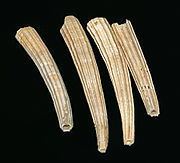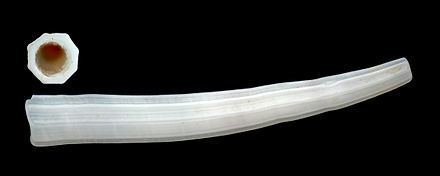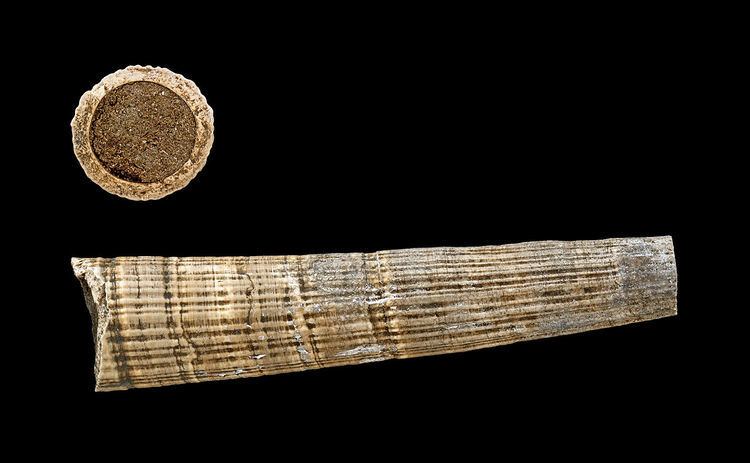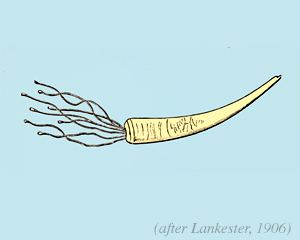Rank Genus | Scientific name Dentalium | |
 | ||
Lower classifications | ||
Dentalium is a large genus of tooth shells or tusk shells, marine scaphopod molluscs in the family Dentaliidae. The genus contains 50 described species and about 50 extinct species.
Contents

Etymology

The scientific name of this genus comes from the Latin word dentis, meaning tooth, based on the tooth or tusk-shaped form of these molluscs.
Description
The mantle of Dentalium species is entirely within the shell. The foot extends from the larger end of the shell, and is used to burrow through the substrate. They position their head down in the substrate, with the apical end of the shell (at the rear of the animal's body) projecting up into the water. These molluscs live on seafloor sediment, feeding on microscopic organisms, detritus and foraminiferans.
The shells are conical and curved in a planispiral way, and they are usually whitish in color. Because of these characteristics, the shell somewhat resembles a miniature elephant's tusk. They are hollow and open at both ends; the opening at the larger end is the main or anterior aperture of the shell. The smaller opening is known as the apical aperture.
Native Americans

The shells of Dentalium neohexagonum are known to have been used by the Chumash people as a form of currency at least as early as circa 1000 AD, in the Morro Bay area.
18th-century European use

In pre-modern medicine, these shells were considered an excellent alkali, and apothecaries would pulverize them for use in several preparations. The shell used for this purpose was described by Joseph Pitton de Tournefort in London in the 18th century as being "of a tubular, or conical form, about 3 inches long; of a shining, greenish white; hollow; light, and divided lengthwise by parallel lines, running from top to bottom. It is about the thickness of a feather, and bears some resemblance to a canine tooth." However, it was considered at that time to be very rare, and in lieu of that, another shell was usually substituted. This was described as a multi-colored shell found in the sand where the tide had fallen; this shell was not channeled, or fluted. The large green shell to which the writer first refers must have been either Dentalium elephantinum or Dentalium aprinum, both of which are large and greenish, and live in the Indo-Pacific zone. The other shell was presumably another species, possibly Dentalium entale, which is native to Great Britain.
Species
Species within the genus Dentalium include:
Extinct species
Extinct species within the genus Dentalium include:
Fossils in the genus Dentalium are geographically widespread. This genus is very ancient, going back up to the Silurian period (age range: from 422.9 to 0.0 million years ago). It is especially represented in Cretaceous, Eocene and Miocene fossils.
